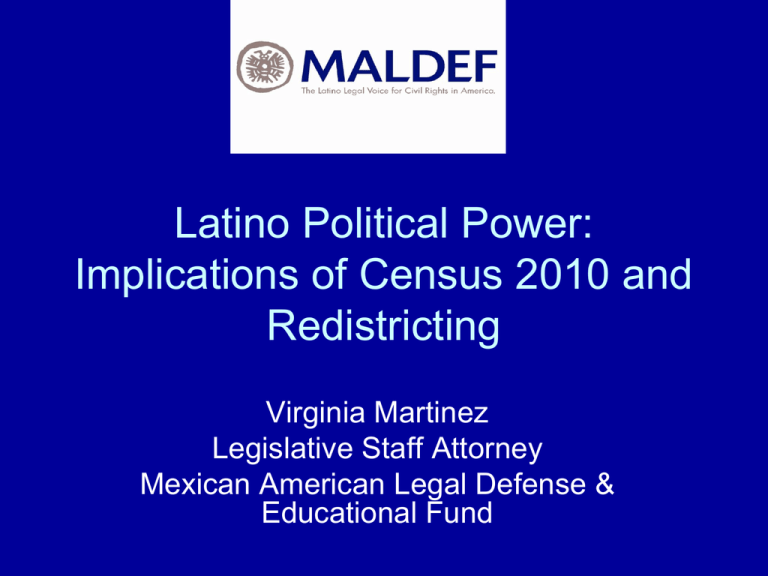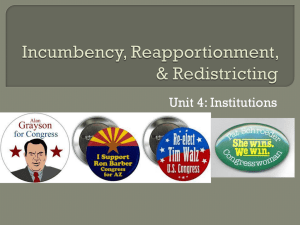PPT - McCormick Foundation
advertisement

Latino Political Power: Implications of Census 2010 and Redistricting Virginia Martinez Legislative Staff Attorney Mexican American Legal Defense & Educational Fund • Founded in 1968 in San Antonio, Texas • The nation’s leading nonprofit, Latino legal organization • Chicago Office opened in 1980 • Mission: to safeguard the rights of Latinos in the U.S. • Performs its work through community education, public policy advocacy, and litigation What we do • Work in four Program Areas Political Access-Voting Rights Employment Immigration Education • Also work on Language and Public Resource Equity Issues What is “redistricting”? Draw (and re-draw) lines that determine which voters are represented by each legislative seat • Federal • State • Local Why re-draw district lines? • Population moves, creating lopsided districts where some votes are worth more than others Constitutional mandate to redraw lines Baker v. Carr, 1962 “One person, one vote” Districts have to have roughly equal population And so… 2000 ― Census Day 2001 ― Redistricting 2010 ― Census Day 2011 ― Redistricting 2020 ― Census Day 2021 ― Redistricting Key redistricting dates April 1, 2010 ― Census Day January 10, 2011 ― Apportionment to U.S. House April 1, 2011 ― Redistricting data to states June 30, 2011 ― IL legislature draws leg. districts (IL commission draws leg. October 5, 2011 ― districts) end of 2011 session ― IL legislature draws Cong. districts Why does redistricting matter? Barack Obama’ s house • Politicians choosing their voters • Eliminating incumbents or challengers 200 0 • Diluting minority votes 200 2 • Splitting up communities Why does redistricting matter? Ultimately determines which laws get passed Determines who controls the legislature Can change the outcome of an election and decide the size of a community’s voice in government Determines whether a community can elect the representative of its choice Redistricting What is Gerrymandering: Manipulation of District Lines to Unduly Increase a group’s Political Power • Term is inspired by Elbridge Gerry, Governor of Massachusetts who signed a redistricting plan ensuring his party’s domination of the state senate in 1812 • This notable district became known as the “Gerrymander” after an artist added the details • “One person one vote” and the Voting Rights Act are supposed to prevent gerrymandering, but it still exists Who draws the lines in Illinois • Congress: State legislature (subject to veto) • State lines: State legislature (subject to veto) and if no agreement, then backup commission - eight members (chosen by legislative leaders) - one random tiebreaker (out of Lincoln’s hat) “Where” starts with federal protections • Equal population • Race and ethnicity Equal population – one person, one vote • Congress: as equal as possible • State legislature: ~10% spread if good reason The Voting Rights Act • Voting Rights Act protects minorities when the lines could be drawn to give a minority community the opportunity to elect its candidate of choice, but the district lines instead split the community up into separate districts where its voting power is diluted. The court uses a “totality of the circumstances” test to determine if minority voters are adequately protected. • It is OK, under the constitution, to consider race and ethnicity, among other factors, in drawing district lines around smaller populations of minorities • Race and ethnicity just can’t “predominate” without a really good reason Gingles* Factors To establish a VRA § 2 violation, you must prove: 1. That the minority group is sufficiently large and geographically concentrated to make up a majority in a single-member district; 2. That the minority group is politically cohesive— that is, it usually votes for the same candidate, and, 3. That, in the absence of special circumstances, the white majority votes together to defeat the minority’s preferred candidate. * Thornburg v. Gingles, 478 U.S. 30 (1986) Senate Factors require a practical analysis “whether the political processes are ‘equally open’ depends upon a searching practical evaluation of the ‘past and present reality,’” White v. Regester, 412 U.S. 755 (1973); see also Senate Report 30. “the ultimate conclusions about equality or inequality of opportunity were intended by Congress to be judgments resting on comprehensive, not limited, canvassing of relevant facts.” Johnson v. DeGrandy, 114 S.Ct. 2647, 2657 (1994) Bottom Line: “Section 2 thus prohibits any practice or procedure that, ‘interact[ing] with social and historical conditions,’ impairs the ability of a protected class to elect its candidate of choice on an equal basis with other voters.” Voinovich v. Quilter, 507 U.S. 146 (1993), quoting Thornburg v. Gingles, 478 U.S. at 47. • Satisfying the Gingles preconditions is insufficient to win the case; you must prove a violation under the “totality of circumstances” by demonstrating some combination of the Senate Factors Minority representation Cracking Packing The Voting Rights Act • Do minorities represent most of the voters in a concentrated area? • Do whites vote for different candidates than minorities? • Is the minority population otherwise protected given the “totality of the circumstances”? Do Not Dilute After federal law, add Illinois limitations Congress: • No state limits State legislature: • Contiguity • Compactness • Nesting Illinois Voting Rights Act of 2011 • Crossover districts—where the minority is potentially large enough to elect the candidate of its choice with help from voters outside the minority; • Coalition districts—where more than one minority group could form a coalition to elect the candidate of their choice • Influence districts—where a minority can influence an election outcome even its preferred candidate cannot be elected A quick review State legislature Congress • Who? State legislature (+ backup, + courts) State legislature (+ courts) • Where? Equal protection Equal protection Voting Rights Act Voting Rights Act Illinois Voting Rts Act Contiguous Compact Nested And then they do what they want MALDEF redistricting litigation in Illinois Del Valle v. Ill. State Bd. Of Elections 1980 • State redistricting commission drew districts that split up the Hispanic population centers in Chicago. The commission justified it by analogizing them to “snowsuits” bought too large for a child to grow into, saying they were drawn to accommodate future population growth • Plaintiffs challenged this explanation by noting that no other racial, ethnic or political group was fitted to “snowsuit” districts and that the Commission's actions served to exacerbate existing underrepresentation of Hispanic interests in the General Assembly-which at the time was zero. A new Commission plan was adopted. Del Valle (continued) • African Americans challenged the way that that the voting districts traced the boundary lines of heavy African American concentration in Chicago’s South Side and therefore constituted “packing.” They referred to this as a “racial wall” constructed by the boundaries. Crosby v. State Board of Elections • This was found to be a VRA violation because the lines of the district followed lines of African American population concentration too closely. This resulted in “packing.” The court ordered the commission to create a new map. MALDEF and Congressional redistricting Hastert v. Bd. of Elections 1991 • After litigation, Plan adopted that included creating this District • Court found that the Voting Rights Act warranted creating a super-majority Hispanic district 4th Congressional “Earmuff” District This is not gerrymandering, but rather protecting voting rights (majority Hispanic district surrounding a majority black district) • Court found that the VRA mandated maintaining three African American districts and chose a plan that avoided “packing” the African American community. MALDEF and Congressional redistricting King v. Bd. of Elections 1997 • Plaintiffs challenged the district under the Equal Protection Clause 4th Congressional “Earmuff” District • The Court, however, held that the district's configuration served a compelling state interest: redressing "an established Section 2 violation" against the Hispanic community in Chicago. There was no violation. Later affirmed by the Supreme Court. Redistricting of Aldermanic Wards Velasco v. Byrne 1984*** Latino and African American plaintiffs alleged the defendants’ map redrawing the Chicago wards illegally diluted voting strength through fracturing, packing, boundary manipulation, and retrogression. The court found a Section 2 violation based on retrogression and ordered a new map. Bonilla v. City Council of Chicago 1992 Bonilla plaintiffs also alleged that the map redrawing the Chicago wards fractured Hispanic communities and diluted their voting power as well as challenging the redistricting process. ***Later consolidated with Ketchum v. Byrne Before 1980 the Census also failed to even consider Hispanics as an ethnic minority Why does redistricting matter? If you care about representation, and you care about political power, then you care about redistricting Help connect the dots • Politicians choosing their voters • Packing districts to win political control • Eliminating incumbents • Eliminating challengers • Diluting minority votes • Splitting up communities Influencing redistricting (short-term) • Educate your community • Identify and map community boundaries • Attend hearings and talk to your legislators • Show where the boundaries should be Influencing redistricting (long-term) There is hunger for change Source: Paul Simon Public Policy Institute, Poll 9-10/09 resource The Impact of Redistricting in Your Community: A Guide to Redistricting http://www.maldef.org/assets/pdf/Redistricting.pdf Brennan Center Guide to Redistricting http://brennan.3cdn.net/dbda15133afb14c05b_i4m6b40of.pdf Thanks to Brennan Center for slides used in previous presentation by MALDEF and Brennan Center Mexican American Legal Defense & Educational Fund Elisa Alfonso, Redistricting Coordinator 312-427-0701







